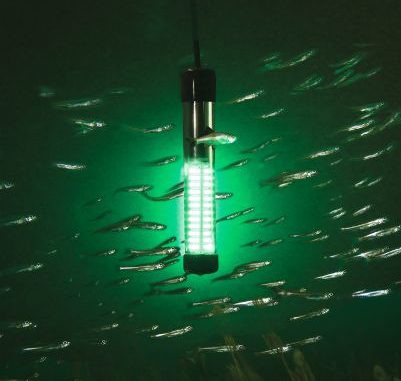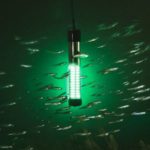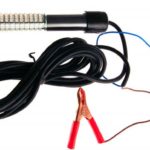
Call the fish to you with Aqua-Vu Bio-Lume
Crossing a bridge over a southern reservoir on a summer night can treat you to a light show that really makes you want to wet a line. When the bite is on and the word is out, the flooded timber can be dotted with enough lights to look like a field of stars.
My earliest experience with this phenomenon involved a Coleman lantern clamped on the side of an open aluminum boat that was tied to standing timber or anchored under a bridge.
The light drew flying bugs, and those we didn’t swat as they tried to eat us sometimes ended up fluttering on the water’s surface until they disappeared in swirls.
Light from the softly hissing lantern also attracted microscopic waterborne critters, which attracted baitfish that then attracted what we were really after.
Crappies were the most-welcome visitors, but we were happy to settle for white bass, striped bass, hybrids, largemouths, sunfish and an occasional catfish. Fishing is fishing, however you do it, and the action ranged from sleepy, head-nodding and sluggish on up to too-fast-to-keep-your-hooks-baited.
Graduating to faster and more-capable fishing boats seemed to trigger an antsy dislike in me for sitting in one spot, and I started fishing on the move just as I did in daylight.
I discovered how to take advantage of the fish-drawing lights on docks, boat houses and even big street lights found on bridges and dams.
When I lived in Dallas, my favorite night-light fishing reservoir was Cedar Creek Lake. I set up a route of lighted docks and boat houses, and worked them in order. I’d kill the outboard about 100 yards out from each spot and creep in on the electric motor, casting to the edges of the light first and slowly working my way in where I could reach the water right under each light with a cast.
White or black jigs, grubs, Roadrunners or small crankbaits were my lures of choice, and I’d start with a surface retrieve and work my way deeper until I found the most-productive depth.
I also night-fished Lake Grapevine before the big DFW airport was built, and I sometimes fished the riprap along the dam all night.
There was almost always a dead street light along the road on top of the dam, and I’d slip into the dark area it caused and fish toward the lights on both sides of it.
This was mostly bass fishing and I used medium- to deep-running black or white crankbaits. I also kept one rod rigged with a black plastic lizard, and if a fish hit and missed a crankbait, I’d reel in quickly and pitch the lizard to the spot.
That technique helped me catch my biggest bass from Grapevine, a largemouth just shy of 7 pounds.
Texas experimented with stocking walleyes in a few lakes back then, and the only ones I ever caught were on crankbaits fished at night along the Grapevine dam.
Lake Travis became my favorite night-fishing impoundment after moving to Austin. Drought-reduced lake levels have put many of my old lighted dock and boat house spots on dry land.
Much of the standing timber I used to fish in Texas and Louisiana lakes has disappeared over the years, but what’s left of the trees and submerged brush can often still be found with sonar and marked with GPS waypoints.
This brings me full circle back to anchoring over cover and fishing with a light.
The fish are still down there, and Aqua-Vu — the Minnesota company that started the underwater video camera movement years ago — has come up with a cutting-edge light source to lure them to you.
Aqua-Vu’s Bio-Lume light system is designed to jump start the food chain activity under your boat. It is a waterproof, submersible light containing a five-sided array of 180 high-intensity LEDs. It provides 360-degree illumination out to at least 200 feet, which attracts plankton and other tiny light-sensing critters. Baitfish are pulled in, and they ring the dinner bell for your targeted game fish.
This is also a great predawn way to lure shad schools into cast-net range for daytime striper fishing trips. It also works in saltwater for both night fishing and gathering bait.
Dr. Jason Halfen is a fish behavior researcher, university professor and angling technology expert. For those who would rather hear it in technical terms, Halfen said, “Savvy anglers who fish after dark have long recognized the importance of small-area light sources and the positive impact they can have on catch rates. Light sources like the submersible Aqua-Vu Bio-Lume positively impact catch rates by influencing multiple aspects of the predator-prey relationship.
“Even short-term use of submersible light sources can stimulate the local food web. Phytoplankton and zooplankton are instinctively drawn to these light sources. A high concentration attracts minnows and other small, plankton-eating fish which in turn draws predator fish to the illuminated area.”
The Bio-Lume light has 16 feet of heavy-duty, waterproof power cable, and it can be powered by most 12-volt batteries. It emits 900 lumens of light, and its LEDs are designed to last for thousands of hours.
Why green light?
“The wavelength-specific green light produced by the Aqua-Vu Bio-Lume is central to its success,” Halfen said. “Water acts like a filter for light, quickly absorbing most colors in the visible spectrum. In aquatic environments, however, only 1 percent of green light is absorbed per meter of water.
“To the angler, this means the light produced by the Bio-Lume will activate an incredibly large volume of water surrounding the light source.”
Any scuba diver will tell you the same thing: As you dive deeper, colors begin fading to shades of gray, and green is the last to go.
Halfen also believes the green light produced by the Bio-Lume is easier on the human eye, does not inhibit our night vision and is less likely to attract pesky flying insects above the surface.
The Bio-Lume unit sells for $49.95 and is designed for use on docks, jetties, piers, boats, and it can even be used for ice fishing. (The way our weather is going, who knows?)
Visit www.aquavu.com for more information.




